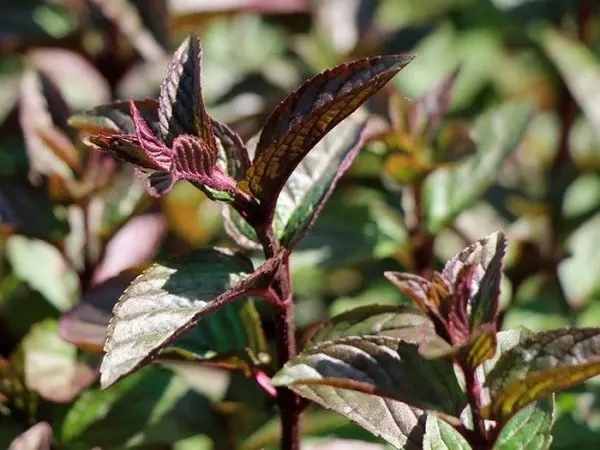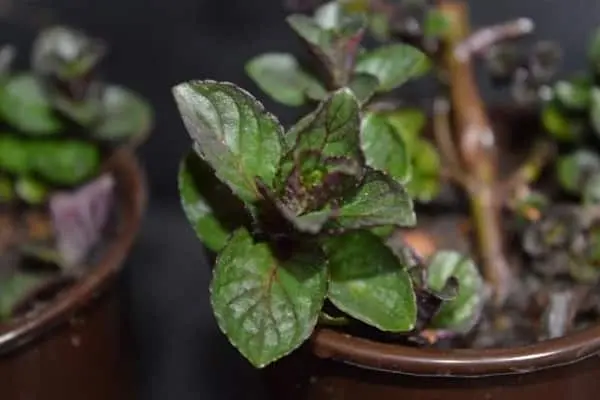Contents
Chocolate mint is distinguished by its unusual foliage color and original aroma. An ornamental plant is widely used by cosmetologists, culinary specialists, folk healers, and is grown by gardeners in household plots. The culture lends itself well to reproduction, storage in dried form.
Description of chocolate mint
The variety was bred by Dutch breeders. A distinctive feature of mint is the presence of a purple-brown hue in color and chocolate aroma, which confirms the name of the culture.

The chocolate variety can be recognized by the purple-brown veins on the leaves.
The plant can be described in more detail as follows:
- The stem of chocolate mint grows vertically. If you pinch the tops, you get a branched bush up to 60 cm high. The skin of the stem is rarely covered with small hairs.
- The arrangement of mint leaf plates is opposite to each other. The shape of the leaf is elongated-rounded. The surface is wrinkled with veins. There are notches on the edges of the leaves. The color is dark green mixed with purple-brown.
- The inflorescences consist of small purple flowers collected in long panicles.
- In place of faded inflorescences, small seeds about 0,5 mm in size appear. After ripening, mint grains acquire a black shell.
You can see chocolate mint in more detail in the photo, where the distinguishing features of the variety are clearly visible.
What is the aroma and taste of chocolate mint
If we compare the culture with other varieties of mint, then its essential oils are soft. There is no sensation of cold from menthol in the mouth. The aroma contains light notes of chocolate.

The chocolate color is intense on the mint tops.
How chocolate mint breeds
The horticultural crop propagates quickly and reliably by layering or dividing the bush, that is, by root cuttings. It is more difficult to start mint on the site using green cuttings and seeds.

On the long root of mint there are many shoots that are convenient to propagate a garden plant
To propagate the variety by the root method, a bush is dug up in the garden in spring, summer or autumn. The roots of mint are long and young shoots grow after a certain distance from them. With scissors, you need to carefully cut such a chain into separate seedlings. Each shoot should be left with a piece of the main root and small branches. Cuttings are planted in pots or immediately in the garden. With abundant watering, chocolate mint will quickly take root. After a couple of weeks, the roots of each seedling will begin to grow, new chocolate-colored sprouts will appear.

If the cut tops of a chocolate plant are placed in a jar of water, they will take root.
When it is not possible to dig up a bush of chocolate mint, it is worth visiting a vegetable market or supermarket. On the shelves you need to find the most freshly cut greens. From the acquired bunch of mint, strong twigs with unfaded leaves are selected. The tops of about 15 cm long are cut off with scissors. The cuttings are placed in a glass of water so that the tips of the stems are immersed to a depth of about 2 cm. A higher water level is not desirable. The cuttings will start to rot.
After a few days, the mint stalks will sprout roots. They continue to be kept in water until the root system grows up to 7 cm long. Ready-made seedlings are planted in cups with a fertile substrate. When the plants get stronger, grow up, they are transplanted to the garden.

Mint seeds can be grown in an ordinary plastic basin
The most difficult and time-consuming process of propagation of chocolate garden mint is growing it from seeds. Tricks can happen here, as unscrupulous manufacturers sometimes pack the wrong varieties that are drawn on the packaging. It is better to purchase seeds certified in a nursery or company store.
For sowing, you need to prepare a container. The soil mixture is purchased or made from humus, sand and earth in a ratio of 1: 1: 2. You can add 1 part of peat to the mixture. The soil is loaded into the landing tank, grooves are made with a pencil 5 mm deep. Chocolate mint seeds can be sown thickly. After germination, weak extra sprouts break through. After sowing, the grooves are covered with soil, moistened with a sprayer. The container is covered with a film, placed in a warm room for germination. Mint sprouts will appear around the third week. The film cover is removed, the air temperature in the room is maintained in the range of 20-25 оC. Planting mint in the garden is carried out after picking and hardening the seedlings when it grows up.
Useful properties of chocolate mint
The main beneficial substances of the chocolate variety, like any other mint, are essential oils, in particular, menthol. The plant is used for the preparation of antibacterial compounds. Essential oils relieve stomach pain during inflammation of the mucous membrane, have preventive effects against gastritis. Peppermint teas are useful for colds, sore throats, and are a sedative. Menthol improves blood circulation, the work of the cardiovascular system.

Useful substances are found in a plant of any age
Uses of chocolate mint
Despite the fact that the aroma resembles chocolate peppermint, its beneficial properties are similar to the traditional horticultural crop. The plant is widely used in medicine, cosmetology, and cooking.
In folk medicine
Folk healers prepare infusions from a fragrant plant with chocolate leaves that help cure nervous diseases and disorders of the digestive system. Menthol well relieves attacks of nausea, reduces pressure, promotes vasodilation, facilitates breathing with nasal congestion during a cold.

Mint tinctures are popular in folk medicine.
Decoctions of mint help to remove stones formed in the gallbladder. The antiseptic substances of the plant eliminate skin rashes, diseases of the oral cavity: periodontitis, stomatitis. You can simply rinse your mouth with mint decoction after eating to freshen your breath.
In cosmetology
For the cosmetic industry, mint is a godsend. The extract of a spicy plant is widely used as a flavoring agent. Many people prefer menthol-scented shampoos, soaps, body and hair care products. Since essential oils have antibacterial properties, body care creams, face and hair masks are produced on their basis. From the leaves, women make their own decoctions and infusions to help care for the skin.

Mint is in demand in cosmetology for the manufacture of creams
In cooking
In cooking, chocolate peppermint is used as a spice. It is often added to meat dishes, sauces. Beautiful chocolate leaves are often used simply as a salad dressing. Mint goes well with desserts. Thanks to the chocolate aroma, the plant is popular with bartenders. Leaves are added to alcoholic and non-alcoholic drinks, cocktails, for example, Mojito.

A few mint leaves will add an original taste to any dish.
Planting and caring for chocolate mint
The chocolate variety, like regular mint, loves moisture. The place is selected partially shaded, but not completely covered by the crown of trees. The soil is preferably fertile, sandy or loamy.

If desired, chocolate spice can be grown in a flower pot on the windowsill
If you have ready-made seedlings on hand, you can plant a plant at any warm time of the year. However, if early spring is chosen, then return frosts should be gone. In the autumn, they are planted at least three weeks before the expected frost. During this time, the chocolate culture should have time to take root.
Bushes are planted at a distance of 45-60 cm from each other. They will grow over time. It is advisable to immediately fence off the bed by digging in a curb tape or slate. The fence will prevent chocolate mint roots from spreading all over the area.
Peculiarities of growing
A garden plant with chocolate leaves is not demanding to care for. Mint needs regular watering to grow well. However, you can’t overdo it either. Culture loves moderate moisture, but not stagnant water.

On large plantations with growing mint, it is more convenient to organize automatic watering
While the plants are small, the soil around the bushes is loosened, weeds are removed. When the mint grows, gains strength, it will drown out the weeds. It is advisable to pinch the tops. The process promotes the rapid development of side shoots. The plant turns into a bush, which helps to increase the yield of chocolate leaves.
Feeding should preferably be avoided. Organic and mineral fertilizers can change the flavor of chocolate spice. If the soil is very depleted in the garden, you can fertilize with a mineral complex once in the summer, but this should not be done before the start of harvesting.
Since the culture loves partial shade, it is not placed on the windows of the south side of the building. However, in winter it is required to artificially increase the duration of daylight hours with the help of backlighting. The air temperature is suitable room, within 20-23 оC.
Pests and diseases
The main pests of mint are mint fleas, green shield beetles, mint leaf beetles, aphids, leafhoppers, and slobbering pennits. They suck juice from young shoots, eat foliage, lay larvae.

Fragrant mint leaves sometimes attract pests that settle in colonies on top of the plant.
The problem is the fact that it is undesirable to process chocolate spice with chemicals. It is better to use agrotechnical methods of struggle and folk methods. If the result is unsuccessful, the plantations are sprayed with an insecticide a month before harvesting the chocolate foliage.

Colloidal sulfur is the best assistant in the fight against fungi and other diseases
Of the diseases, mint is affected by powdery mildew, rust. Often the person himself is to blame for the disease of culture. Strong thickening of plantings and excessive dampness of the beds should not be allowed. If the fungus has appeared, the mint is sprayed with a solution of colloidal sulfur a month before harvesting.
When and how to harvest chocolate mint
Aromatic essential oils are found throughout the aerial part of mint. The crop is harvested by cutting off the stems during the beginning of flowering. With good care, you can get three harvests of chocolate spice in a season. The stems are not cut to the very root, so that the bush has the opportunity to quickly recover. If only chocolate leaves are needed, whole branches are still cut off, and then they are cut off. It is impossible to leave bare stems on a plant.

The harvested crop is formed in bunches, stored in a dried form.
How to dry chocolate mint
A couple of days, a freshly harvested crop can be stored in the refrigerator by wrapping the branches in a damp cloth. Drying is suitable for long term storage. In a natural way, mint is dried for about 15 days, spread out in a thin layer in the shade. To speed up the process, use an oven or microwave. Here the chocolate twigs will dry in 5-6 hours.
The harvest is stored in bunches suspended in the barn on the ceiling or wall. Leaves can be crushed into powder and packaged in hermetically sealed containers.
Conclusion
Chocolate mint on the site will be a great decoration. In addition, the spicy plant will scare away pests from garden crops.









